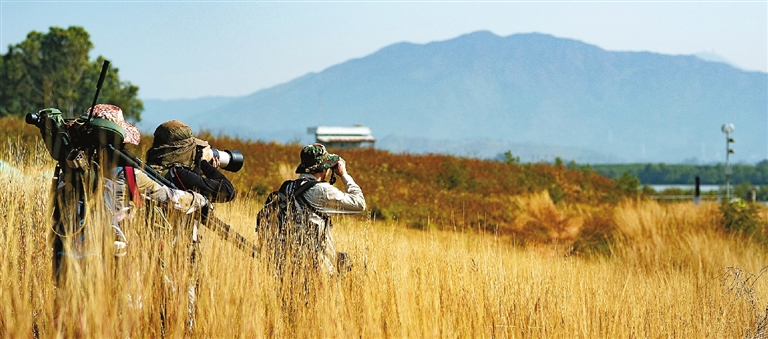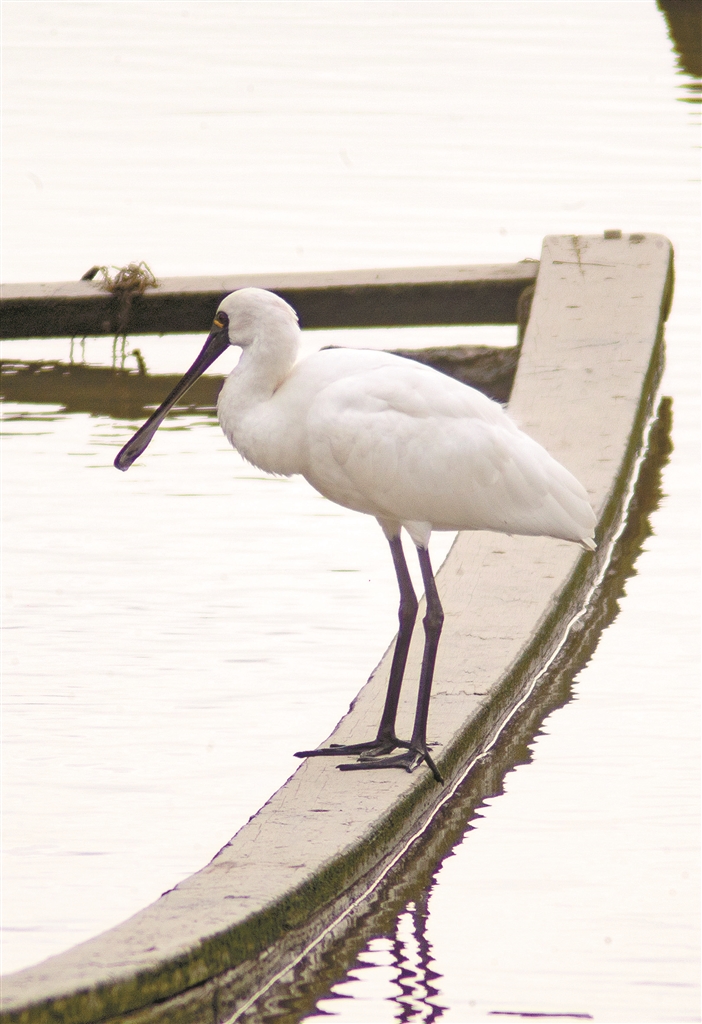




Wang Ying wy_szdaily@126.com AT exactly 1 p.m. on Friday, a team of three, heavily armed with a telescope, binoculars and HD cameras, appeared under a scorching sun on a bridge in the south area of Futian Mangrove Ecological Park. They stopped in the middle of the bridge, swiftly took out their devices and began to attentively search for their objective. Happy and content smiles bloomed on their faces when a black-faced spoonbill resting on a platform on one side of the old mouth of the Xinzhou River popped into sight. They were doing a job much envied by bird lovers: counting birds for the International Black-faced Spoonbill Census. The census, organized by the Hong Kong Bird Watching Society, is conducted annually to assess the wintering abundance and distribution of this globally endangered waterbird. For 2019, it took place on the weekend of Jan. 25 to 27 at the bird’s major wintering sites in East and Southeast Asia. Here in Shenzhen, three sites were selected to participate in this year’s global census: Futian Mangrove Ecological Park, Futian Mangrove National Nature Reserve and Shenzhen Bay Park, which are the main habitats for the bird, according to Zhang Gaofeng, deputy secretary general of the Shenzhen Bird Watching Society, which has been involved in the census since 2004. The Shenzhen census, organized by the Shenzhen Bird Watching Society, Futian Mangrove National Nature Reserve Administration and Shenzhen Mangrove Wetlands Conservation Foundation (MCF), caused quite a stir among local birdwatchers, Zhang said. The chances for getting involved in this fun job were quickly grabbed after the recruitment announcement was made. Jian Qinxiang, a member of the Shenzhen Bird Watching Society, has participated in the census since 2014, six times so far. It was the second time that Wu Jing, a volunteer of MCF and OCT Wetland, has attended the global count. She said she paid particular attention to the increase or decrease of the bird figures, as it could help her explain to the public whether the environment for the bird has improved or deteriorated while leading interpretive tours in parks. “I felt very happy to be part of the global effort,” said Zhou Jun, a volunteer of Futian Mangrove Ecological Park, who often leads educational birding tours inside the park. “I felt lucky to be able to join the project for a second year.” Method The census is unanimously held in mid-winter when the wintering populations of spoonbills are apparently stable, according to the Hong Kong Bird Watching Society. The dates scheduled for the censuses coincide with the dates of the spring tides at Deep Bay between Hong Kong and Shenzhen and the Red River Delta in Vietnam, given that high tides facilitates the counting at these sites. Guidelines on the technical basis are sent to the surveyors in advance of the census. The counts are done within the census period. For some sites within close proximity of each other, such as Mai Po in Hong Kong, Futian in Shenzhen in the Deep Bay area and Taipa-Coloane in Macao, where the spoonbills can fly between these sites within an hour, counts are conducted simultaneously. Censuses depend on volunteer work by local birdwatchers, conservationists, researchers, ornithologists and reserve officers. Yu Lan, a volunteer with Futian Mangrove Ecological Park, was so excited that she couldn’t help but dance when she spotted two spoonbills between 2:30-2:50 p.m. on Sunday, which was her first time on the mission. Census results are summarized by coordinators in the respective regions or individual surveyors before submission to the international coordinator for analysis and announcement. It usually takes at least two months for the results to come out. Bird count goes hi-tech While most counts in the census are made with binoculars and telescopes, some have been done with high-technology in recent years. In this year’s census over the weekend, Futian Mangrove Ecological Park put into use a drone to detect the spoonbills hidden by trees, which binoculars and telescopes failed to locate. “It is very effective to use a drone to find spoonbills hiding far away behind trees,” said Yin Yuzhu, the executive director of the park. “It can take very clear pictures of the spoonbills and thus facilitate the count.” As for worries that the use of a drone may disturb the birds, Yin said each tool has its pros and cons. “If the drone’s flying speed is very fast, it indeed could affect flocks of birds,” Yin added. “For large wading birds, the alert distance is 50 meters. When operating the machine, I always try to keep an appropriate distance from the birds, more than 50 meters, to reduce the disturbance and lower the speed when getting closer.” The drone recorded 48 spoonbills in the park at 4:30 p.m. on Sunday. Natural habitat As a grade-two national protected species and the flagship species of Asia as well as the star bird of Shenzhen, black-faced spoonbills migrate to or stop over in the city on the their flyway every year from September to April. Shenzhen Bay, one of the bird’s most important wintering grounds, recorded 178 spoonbills — 25 percent of the world population of the species — in the winter of 1999-2000, according to an article published in 2002 in the bimonthly publication Ecological Science. Over the years, the number has gradually increased. “There are three factors affecting the population of wintering birds: food source, night stay and safety,” said Wang Yongjun, researcher, senior forestry engineer and former director of Guangdong Neilingding Futian National Nature Reserve Administration and member of the Shenzhen Decision Advisory Committee. “As Shenzhen and Hong Kong are linked by the Shenzhen Bay (Deep Bay), there was a time when birds flew to the Shenzhen side to feed in the day and flew to the Hong Kong side to sleep, just like people commuting to work. Later, birds began to choose to stay on the Shenzhen side for both food and night stay, which indicates that Shenzhen’s natural habitat as a wintering site has improved.” Futian Mangrove Ecological Park, small as it is, is an ecological corridor connecting Futian Mangrove National Nature Reserve and the Mai Po marshes in Hong Kong due to its special geographical location, protecting the critical habitats of various living creatures. By 2018, the park had recorded 105 kinds of birds, of which six were grade-two national protected species. At OCT Wetland, the only wetland in the center of a metropolis in China, a single black-faced spoonbill has been spotted many times each year since 2016, although no one can be sure whether it is the same bird. However, it became one of the 3,941 black-faced spoonbills in the global censuses of 2017 and 2018. “Although human development has made the area of wetlands shrinking and has damaged the eco-structure, which could largely affect the birds, the current situation is optimistic,” said Wang. “With more efforts devoted to eco-construction and ecological civility, the public has become more aware of our ecological system.” What’s more important is that the city leadership is paying greater attention to the protection of wetlands and the natural ecosystem in recent years and many measures launched are very encouraging and effective, he added. Black-faced spoonbill A large wading bird with a distinctively shaped beak — looking like a spoon, or a pipa, an ancient Chinese musical instrument, it has black facial skin, hence its name. It is also known as the black-faced dancer because of its elegant posture. The birds use a tactile method of feeding, wading in the shallow water and sweeping their partly opened bills from side to side to detect prey. The moment any small aquatic creature touches the inside of the bill — an insect, crustacean, or tiny fish — it is snapped shut. Found along the East Asian and Southeast Asian coasts, the birds are known to breed on islands off the coast of North and South Korea and in Liaoning Province, China. Following the breeding season, the population migrates to wintering grounds. | 
